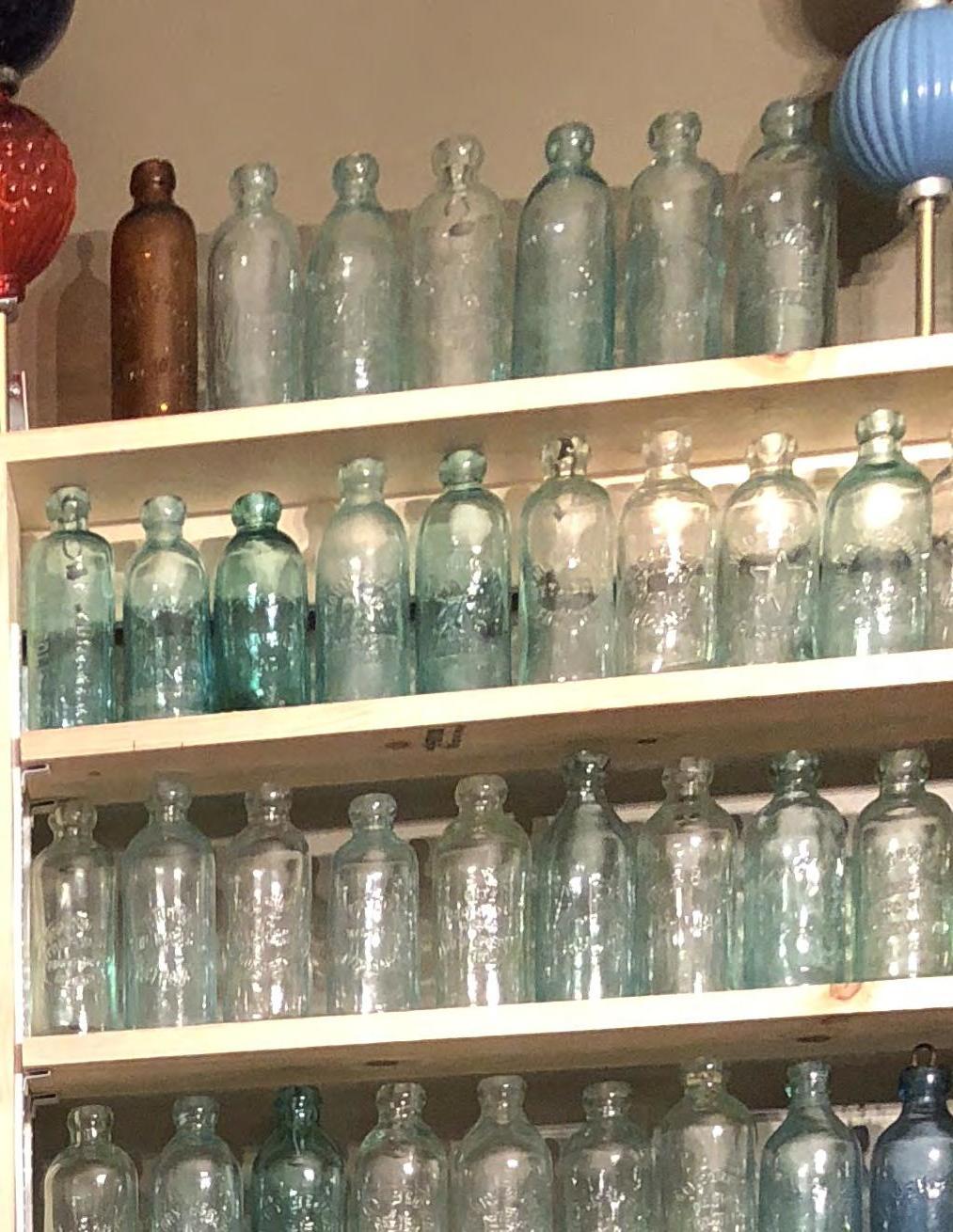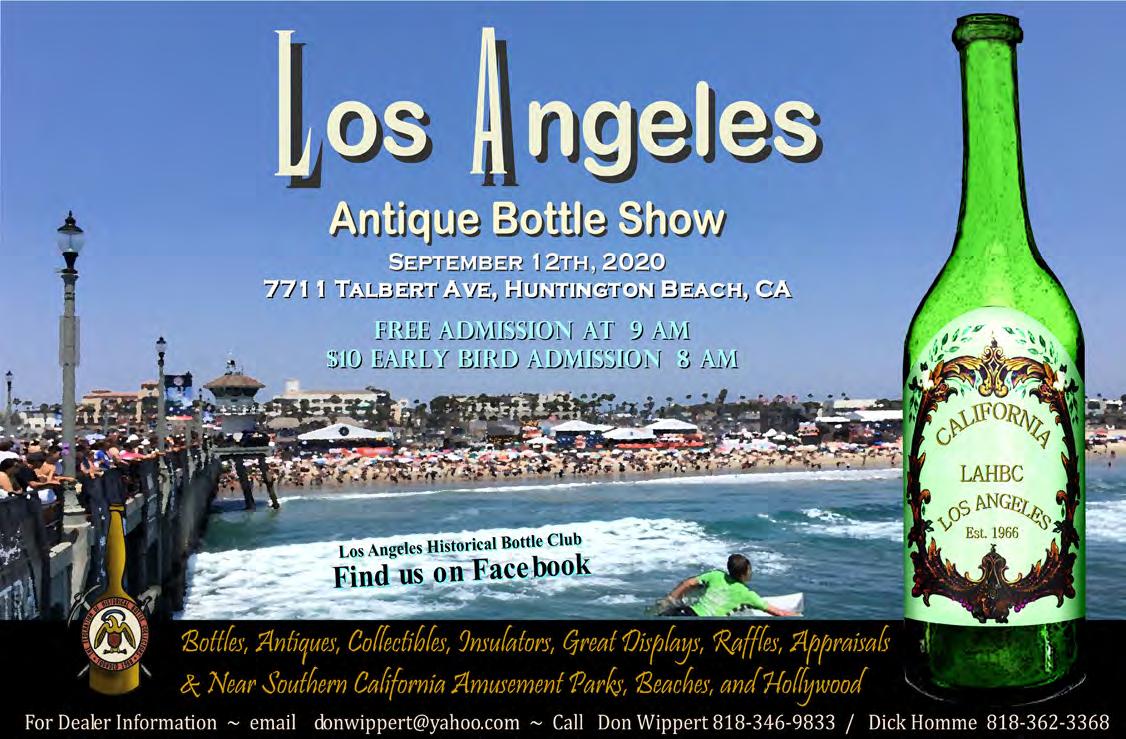
10 minute read
Ingredients in Pontiled Medicine Bottles by Burt Robbins

Ingredients in Pontiled


Medicine



Bottles



By Burt Robbins
Some of the many ingredients used in pontiled medicines
In late 1979, I wrote an article for Old Bottle Magazine in which I outlined the reasons why collecting open pontiled medicine bottles was becoming popular and why this category of bottles can easily be related to the history of science and medicine. At that time, I taught high school sciences and had over 200 pontiled medicine bottles in my collection. Then in 1980, I went to pharmacy school and stopped collecting until just recently. As a result of my studies and new career in pharmacy over the last 30 years, I have developed a new perspective about the development and efficacy of these early medicinal preparations. I am writing now to stimulate rethinking about these so-called quack concoctions and alleged useless nostrums.
While some of the preparations that were bottled during the pontiled medicine era (about 1830-1850) were undoubtedly the result of moneymaking schemes by businessmen or profiteering doctors with little regard for medical results, many were honest attempts to treat the diseases and afflictions of the day. Later in this article, this will be seen to be evident by reviewing the ingredients from which they were made. In 1820, when embossed pontiled bottles were just starting to be produced to contain medicinal preparations, there were big changes occurring in the field of the treatment of disease. At that time and up to 1858 the humoral theory of disease was slowly being discredited. As a result of the humoral theory, patients were being profusely bled
This large Botanic Druggists bottle illustrates how medicinal preparations of the mid 1800’s sought to calm the fears of the public, and implying that safe and harmless plant ingredients were used in compounding.

Dr. S. Fellers Eclectic Liniment from Ohio ca 1850. The eclectic physicians and pharmacists would practice their profession by following the American Eclectic Dispensary when compounding medicines.

or leached to purge them of their so-called bad humors, or they were being poisoned by preparations of arsenic or mercury (calomel). George Washington’s death in 1799 is thought to have been hastened by his doctors excessively bleeding him to remove bad humors. As a result of these injurious practices, many people began to avoid doctors and to self-diagnose and treat themselves.
Rosemary is mainly used now as an herb in cooking, but the oil contains 10-20% camphor and may have been taken for indigestion or applied as a counterirritant. In this preparation, it may add flavor to the castor oil and help preserve it. Castor oil was applied externally to heal wounds or used as a laxative when used internally. It is easy to understand why by the 1820s the eclectic movement began and became stronger by the 1840s and onward. Its name comes from the Greek meaning ‘to choose from’ and it recognized principles of botanic medicine to cure disease. It was a reaction against the harsh and unproductive treatments of earlier times in favor of utilizing the many years of botanical knowledge in European, Indian, Oriental, and American cultures. Of course, today we now know that many botanicals are effective in treating disease.
In the era of pontiled medicine bottles, many people were migrating to western territories. Water and food were often bad and doctors were often unavailable in rural areas. A bottle of medicine in one’s possession was often considered invaluable because any kind of rational self-treatment could be better than none.
The basis of my argument is that we do not often consider the possible good that these bottled ingredients might do. Much has been written about the abuse of cannabis, cocaine, opium, morphine, alcohol, and other drugs contained in many preparations during the pontiled era, but after 1860 things got worse, until the Pure Food and Drug Act was passed in 1906. Everyone has heard of these claims of addiction and there is some truth to these claims of abuse. The temperance movement arose as a result of too much alcohol being consumed by too many people and it resulted in the passage of the 18th amendment. Frequently, the result was addiction for the patient and misdiagnosis by the doctor. Let’s consider a different point of view and see how a few examples of the bottled ingredients could benefit the patient. Many of these preparations should be considered as honest attempts to cure the patient using the materials and knowledge at hand.
Alcohol is a pharmacologic depressant and was often an important ingredient in the medical preparations of the pontiled era. It also is useful as a solvent to dissolve and extract the active ingredients in plants. The labeling on the bottles of the various preparations often stated alcohol’s use as a preservative and it was often an ingredient in external balms and liniments as well as a counterirritant or a wound cleanser without knowing why it was beneficial. The bottled botanical ingredients could be

(Left Image) The embossing on this bottle says it all!

(Right Image) Roots and herbs were considered safe to be taken and a natural alternative to the ineffective and often deadly medicines of previous years.
subject to rapid decay without it. The only other preservatives of food and medicine of the era were salt, possibly sugar, dehydration, vinegar, and wood smoking and curing. The low cost, easy availability and the preservation and solvent properties of alcohol made it a first choice for preserving medicines. In addition to its preservative and solvent properties, alcohol has many effects upon the human body. The misuse of alcohol is widespread and well known but in the absence of anything better, alcohol itself in the 1800s was found to have some medical use. Alcohol has a depressant effect on the nervous system making it possibly useful for a makeshift treatment for pain and insomnia. For this it was reasonably fast and somewhat effective but alcohol is a vasodilator and we now know it may increase the bleeding of wounds. Alcohol was thought to aid in the reduction of fevers and angina although oddly it was taken at times to stimulate the heart. As an important part of many preparations it was given to infants and children as well as adults as a sleep aid. Alcohol can relieve flatulence. If whiskey or certain higher proof medicinal preparations were added to contaminated water, the water was safer to drink thus saving many lives. This era also saw the rising of the temperance movement and many people who would not otherwise consume whiskey would, if needed, take a medicine that contained alcohol. Not only did the alcohol work to preserve the bottled preparation but also quickly worked in many cases to relax the patient, perhaps dull pain, and make him or her feel somewhat better. Of course, this effect is not a cure and does not address alcohol’s addictive potential and other long-term harmful effects upon the body. Nowadays the limited beneficial properties of alcohol in medicine have been replaced by other ingredients and in 1916 whiskey and brandy were no longer listed as scientifically approved medicines in the U.S. Pharmacoepeia. Later, even during prohibition, alcohol for medicinal use could be obtained from pharmacies by prescription.
Opium was another unregulated ingredient for many of the botanical preparations that were put up in pontiled medicine bottles. It contained morphine as the main active ingredient and was produced from an extract of the poppy plant. It was effective but addictive especially in non-pain situations. Many side effects and adverse reactions were possible with its use but for isolated people in need and no other help available, it could be helpful. It was often abused but generally acknowledged that the relief of pain was beneficial for all involved. It was also used to treat diarrhea and coughs. In the early 1800s,
Cod liver oil is still being used today but of course is now often deodorized. It contains Omega 3 fatty acids and vitamins A and D which would have been helpful in treating dietary deficiencies such as rickets or could be applied externally.


morphine was isolated from opium and began to replace opium because the dose could be better controlled.
The leaves, roots, fruit, and bark of many plants contain pharmacologically active compounds that act upon the human body. This has been known for thousands of years. Even today about 25% of prescribed medicine is derived from natural sources. The effects of the active ingredients of plants on the human body are now receiving more scientific attention and many plant products are being marketed as food or dietary supplements that can be purchased without a prescription. The pine tar, rock rose, dandelion, hops, chamomile, ipecac, and so many more of the botanicals found in the bottled preparations of the mid 1800s could have produced positive results for the patient. The potential is there, but there were many problems: faulty self-diagnosis, physician misdiagnosis, subtherapeutic or toxic concentration of active ingredients, loss of potency, high alcohol content (especially in the late 1800s), and little or no scientific testing could all produce a negative outcome.
In the 1840s there were few cures for disease. So then, these early preparations were formulated in many cases as an honest attempt to use available materia medica botanicals to treat the patient based on the properties of the ingredients. They may have been misdirected and ineffective in many cases but they may have alleviated symptoms and relieved suffering. We look back at these preparations and see humble beginnings, and to the future and imagine more progress. The practice of medicine is a continuous process and to describe all the preparations of the pontiled era as bogus, dishonest, and solely profit-motivated is not supported by the facts.

Indianapolis Circle City Antique Bottle, Advertising and Antiques Show Saturday, September 19, 2020
Bottles of all types Advertising
Boone County Fairgrounds 1300 E. 100 S. Lebanon, IN 46052
Ephemera or Go-withs Table Top Antiques
Set Up: 7:30am - 9am Show Hours: 9am - 2pm Admission - FREE (Early Admission - $20.00)

Free Appraisals on Antique Bottles and Glass
For Show Information Contact:
Martin Van Zant (812) 841 - 9495 41 East Washington St. Mooresville, IN 46158 mdvanzant@yahoo.com or
“Balsam” Bill Granger (317) 517 - 5895 6915 S. 280 E. Lebanon, IN 46052 bgranger@iquest.net
Monument Dr.
INTERSTATE 65
Exit Ramp N Indianapolis Ave. Boone County Fairgrounds 1300 E 100 S Lebanon, IN 46052
N. 156th St.
Show Here
INTERSTATE 65
Copeland Neese Rd
Indiana Brewriana Club
Exit 138
Show Address: Boone County Fairgrounds 1300 E 100 S Lebanon, IN 46052
Exit Ramp
50th Annual
ATLANTA ANTIQUE
BOTTLE SHOW & SALE
SPONSORED BY THE R.M. ROSE COMPANY
Friday & Saturday September 11 & 12, 2020
Southern Pottery, Antique Bottles, Fruit Jars, Advertising, Post Cards, Milk Bottles and other Table Top Antiques
Dealer Setup & Early Admission Friday, Sept. 11th., 3:00 pm - 8:00 pm & Saturday, Sept. 12th., 7:00 am to 9:00 am Public General Admission Saturday, Sept. 12th., 9:00 am - 3:00 pm Smyrna Community Center, 200 Village Green Circle, Smyrna, Georgia 30080 Early Admission with Dealers: $20 C an elled which includes barbecue dinner Friday night
Public FREE ADMISSION on Saturday
For table reservations & show information contact:
Jack Hewitt
Box 12126 Big Canoe Jasper, Georgia 30143 770-856-6062
Bill Johnson
770-823-2626 bj3605@comcast.net
Free Bottles for Kids, Prizes & Appraisals on Saturday









